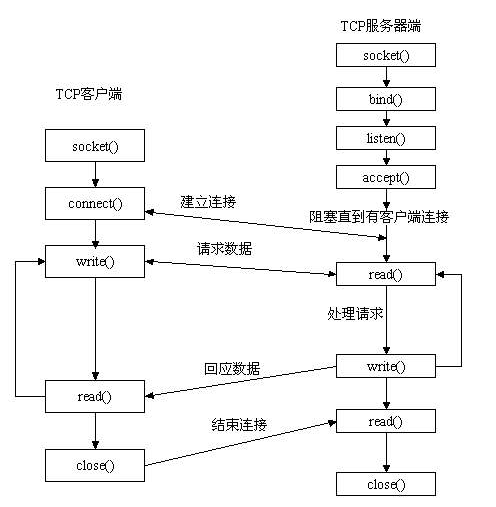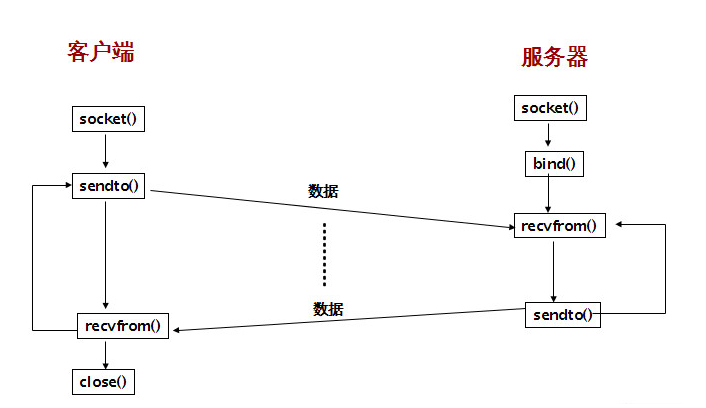c Socket编程(C语言实现)——基于TCP协议,基于UDP协议(多线程,循环监听)(网络间通信AF_INET,典型的TCP/IP四型模型的通信过程) 代长亚 2024-10-31 2025-09-05 Socket编程
目前较为流行的网络编程模型是客户机/服务器通信模式
客户进程向服务器进程发出要求某种服务的请求,服务器进程响应该请求。如图所示,通常,一个服务器进程会同时为多个客户端进程服务,图中服务器进程B1同时为客户进程A1、A2和B2提供服务。
Socket概述
① 所谓Socket通常也称作“套接字”,用于描述IP地址和端口,是一个通信链的句柄。应用程序通常通过“套接字”向网络发出请求或者应答网络请求。
② Socket是连接运行在网络上的两个程序间的双向通信的端点。
③ 网络通讯其实指的就是Socket间的通讯。
④ 通讯的两端都有Socket,数据在两个Socket之间通过IO来进行传输。
套接字socket的类型
(1)流式套接字(SOCK_STREAM)
提供面向连接、可靠的数据传输服务,数据无差错、无重复的发送,且按发送顺序接收(TCP协议)
(2)数据报式套接字(SOCK_DGRAM)
提供无连接服务,数据包以独立包形式发送,不提供无措保证,数据可能丢失,并且接收顺序混乱(UDP协议)
(3)原始套接字(SOCK_RAM)
套接字(socket)
socket起源于Unix,而Unix/Linux基本哲学之一就是“一切皆文件”,都可以用“打开open –> 读写write/read –> 关闭close”模式来操作。Socket就是该模式的一个实现,socket即是一种特殊的文件,一些socket函数就是对其进行的操作(读/写IO、打开、关闭).说白了Socket是应用层与TCP/IP协议族通信的中间软件抽象层,它是一组接口。在设计模中,Socket其实就是一个门面模式,它把复杂的TCP/IP协议族隐藏在Socket接口后面,对用户来说,一组简单的接口就是全部,让Socket去组织数据,以符合指定的协议。
随着Unix的应用推广,套接字有被引进了windows等操作系统。套接字通常只与同一区域的套接字交换数据,windows socket只支持一个通信区域:网际域(AF_INET) ,这个域被使用忘记协议簇的通信进程使用。
使用Socket进行网络通信的过程
① 服务器程序将一个套接字绑定到一个特定的端口,并通过此套接字等待和监听客户的连接请求。
② 客户程序根据服务器程序所在的主机和端口号发出连接请求。
③ 如果一切正常,服务器接受连接请求。并获得一个新的绑定到不同端口地址的套接字。
④ 客户和服务器通过读、写套接字进行通讯。
客户机/服务器模式
在TCP/IP网络应用中,通信的两个进程间相互作用的主要模式是客户机/服务器模式*(client/server),即客户像服务其提出请求,服务器接受到请求后,提供相应的服务。
服务器:
(1)首先服务器方要先启动 ,打开一个通信通道并告知本机,它愿意在某一地址和端口上接收客户请求
(2)等待客户请求到达该端口
(3)接收服务请求,处理该客户请求,服务完成后,关闭此新进程与客户的通信链路,并终止
(4)返回第二步,等待另一个客户请求
(5)关闭服务器
客户方:
(1)打开一个通信通道,并连接到服务器所在的主机特定的端口
(2)向服务器发送请求,等待并接收应答,继续提出请求
(3)请求结束后关闭通信信道并终止
基于TCP(面向连接)的socket编程
流式传输: “客户端”,1.socket()函数;2.bind()函数可有可无,加上指定传输端口,不加随机分配端口;3.connect()函数,填写服务端的地址与端口【网络间通信AF_STREAM】或者路径【进程间通信AF_DGRAM】;4.send()函数;5.recv()函数。
流式传输: “服务端”,1.socket()函数;2.bind()函数,必须加上指定传输端口【网络间通信AF_STREAM】或者是路径【进程间通信AF_DGRAM】 ;3.listen()函数,使用isockfd;5.accepc()函数,生成新的fd,inewfd;6.send()函数,inewfd;7.recv()函数,inewfd。
服务器端先初始化Socket,然后与端口绑定(bind),对端口进行监听(listen),调用accept阻塞,等待客户端连接。在这时如果有个客户端初始化一个Socket,然后连接服务器(connect),如果连接成功,这时客户端与服务器端的连接就建立了。客户端发送数据请求,服务器端接收请求并处理请求,然后把回应数据发送给客户端,客户端读取数据,最后关闭连接,一次交互结束。
**基于TCP(面向连接)的socket编程——**流式套接字(SOCK_STREAM) 网络间通信AF_INET,典型的TCP/IP四型模型的通信过程
服务器:
1 2 3 4 5 6 7 8 9 10 11 12 13 14 15 16 17 18 19 20 21 22 23 24 25 26 27 28 29 30 31 32 33 34 35 36 37 38 39 40 41 42 43 44 45 46 47 48 49 50 51 52 53 54 55 56 57 58 59 60 61 62 63 64 65 66 67 68 69 70 71 72 73 #include <stdio.h> #include <string.h> #include <arpa/inet.h> #include <sys/types.h> #include <sys/socket.h> #include <netinet/in.h> #include <netinet/ip.h> #define PORT 23 #define BACKLOG 5 int main(){ int iSocketFD = 0 ; int iRecvLen = 0 ; int new_fd = 0 ; char buf[4096 ] = {0 }; struct sockaddr_in stLocalAddr = {0 }; struct sockaddr_in stRemoteAddr = {0 }; socklen_t socklen = 0 ; iSocketFD = socket(AF_INET, SOCK_STREAM, 0 ); if (0 > iSocketFD) { printf("创建socket失败!\n" ); return 0 ; } stLocalAddr.sin_family = AF_INET; stLocalAddr.sin_port = htons(PORT); stLocalAddr.sin_addr.s_addr=htonl(INADDR_ANY); if (0 > bind(iSocketFD, (void *)&stLocalAddr, sizeof (stLocalAddr))) { printf("绑定失败!\n" ); return 0 ; } if (0 > listen(iSocketFD, BACKLOG)) { printf("监听失败!\n" ); return 0 ; } printf("iSocketFD: %d\n" , iSocketFD); new_fd = accept(iSocketFD, (void *)&stRemoteAddr, &socklen); if (0 > new_fd) { printf("接收失败!\n" ); return 0 ; }else { printf("接收成功!\n" ); send(new_fd, "这是服务器接收成功后发回的信息!" , sizeof ("这是服务器接收成功后发回的信息!" ), 0 ); } printf("new_fd: %d\n" , new_fd); iRecvLen = recv(new_fd, buf, sizeof (buf), 0 ); if (0 >= iRecvLen) { printf("接收失败或者对端关闭连接!\n" ); }else { printf("buf: %s\n" , buf); } close(new_fd); close(iSocketFD); return 0 ; }
客户端:
1 2 3 4 5 6 7 8 9 10 11 12 13 14 15 16 17 18 19 20 21 22 23 24 25 26 27 28 29 30 31 32 33 34 35 36 37 38 39 40 41 42 43 44 45 #include <stdio.h> #include <string.h> #include <arpa/inet.h> #include <sys/types.h> #include <sys/socket.h> #include <netinet/in.h> #include <netinet/ip.h> #define PORT 23 #define ADDR "192.168.1.230" int main(){ int iSocketFD = 0 ; unsigned int iRemoteAddr = 0 ; struct sockaddr_in stRemoteAddr = {0 }; socklen_t socklen = 0 ; char buf[4096 ] = {0 }; iSocketFD = socket(AF_INET, SOCK_STREAM, 0 ); if (0 > iSocketFD) { printf("创建socket失败!\n" ); return 0 ; } stRemoteAddr.sin_family = AF_INET; stRemoteAddr.sin_port = htons(PORT); inet_pton(AF_INET, ADDR, &iRemoteAddr); stRemoteAddr.sin_addr.s_addr=iRemoteAddr; if (0 > connect(iSocketFD, (void *)&stRemoteAddr, sizeof (stRemoteAddr))) { printf("连接失败!\n" ); }else { printf("连接成功!\n" ); recv(iSocketFD, buf, sizeof (buf), 0 ); 将接收数据打入buf,参数分别是句柄,储存处,最大长度,其他信息(设为0 即可)。 printf("Received:%s\n" , buf); } close(iSocketFD); return 0 ; }
测试:
1、编译服务器、客户端代码:
1 2 3 4 5 [root@localhost tcp_socket]# make socket_server_tcp cc socket_server_tcp.c -o socket_server_tcp [root@localhost tcp_socket]# make socket_client_tcp cc socket_client_tcp.c -o socket_client_tcp [root@localhost tcp_socket]#
2、服务器端口监听:
1 2 [root@localhost tcp_socket]# ./socket_server_tcp
3、执行客户端:
非telnet:
1 2 3 4 5 6 7 8 9 10 11 服务器端显示: [root@localhost tcp_socket]# ./socket_server_tcp iSocketFD: 3 接收成功! new_fd: 4 接收失败或者对端关闭连接! 客户端显示: [root@localhost tcp_socket]# ./socket_client_tcp 连接成功! Received:这是服务器接收成功后发回的信息!
telnet服务器:
1 2 3 4 5 6 7 8 9 10 11 12 13 服务器端显示: [root@localhost tcp_socket]# ./socket_server_tcp iSocketFD: 3 接收成功! new_fd: 4 buf: �������� ��!��"��'����# 客户端显示: [root@localhost tcp_socket]# telnet 192.168.1.230 Trying 192.168.1.230... Connected to 192.168.1.230. Escape character is '^]'. 这是服务器接收成功后发回的信息!Connection closed by foreign host.
基于UDP(面向无连接)的socket编程
** 报式传输:**“客户端”,1.socket()函数;2.bind()函数,绑定客户端的地址与端口【网络间通信AF_STREAM】或者路径【进程间通信AF_DGRAM】,以便于后续服务端sendto()函数参数的填写。若服务器端只是收不发数据,即,服务端有recvfrom()函数无sendto()函数,则客户端不需要bind()函数;若服务端要发送数据,即,有sendto()函数,则客户端需要bind()函数; 3.客户端sendto()函数参数,填写服务端的地址与端口【网络间通信AF_STREAM】或者服务端路径【进程间通信AF_DGRAM】的结构体地址与结构体长度,服务端必须有bind()函数 ;4.客户端recvfrom()函数参数,NULL,会自动识别。
报式传输: “服务端”,1.socket()函数;2.bind()函数,绑定客户端的地址与端口【网络间通信AF_STREAM】或者路径【进程间通信AF_DGRAM】,以便于后续客户端sendto()函数参数的填写。若服务器端只是收不发数据,即,服务端有recvfrom()函数无sendto()函数,则客户端不需要bind()函数;3.服务端sendto()函数参数,填写客户端的地址与端口【网络间通信AF_STREAM】或者客户端路径【进程间通信AF_DGRAM】的结构体地址与结构体长度,服务端必须有bind()函数 ;4.recvfrom()函数参数,NULL,会自动识别。
**基于UDP(面向无连接)的socket编程——**数据报式套接字(SOCK_DGRAM) 网络间通信AF_INET,典型的TCP/IP四型模型的通信过程
服务器:(多线程的【每10秒会打印一行#号】 与 循环监听)
1 2 3 4 5 6 7 8 9 10 11 12 13 14 15 16 17 18 19 20 21 22 23 24 25 26 27 28 29 30 31 32 33 34 35 36 37 38 39 40 41 42 43 44 45 46 47 48 49 50 51 52 53 54 55 56 57 58 59 60 61 #include <stdio.h> #include <sys/types.h> #include <sys/socket.h> #include <netinet/in.h> #include <netinet/ip.h> #include <pthread.h> void * test(void *pvData){ while (1 ) { sleep(10 ); printf("################################\n" ); } return NULL ; } int main(void ){ pthread_t stPid = 0 ; int iRecvLen = 0 ; int iSocketFD = 0 ; char acBuf[4096 ] = {0 }; struct sockaddr_in stLocalAddr = {0 }; struct sockaddr_in stRemoteAddr = {0 }; socklen_t iRemoteAddrLen = 0 ; iSocketFD = socket(AF_INET, SOCK_DGRAM, 0 ); if (iSocketFD < 0 ) { printf("创建socket失败!\n" ); return 0 ; } stLocalAddr.sin_family = AF_INET; stLocalAddr.sin_port = htons(12345 ); stLocalAddr.sin_addr.s_addr = 0 ; if (0 > bind(iSocketFD, (void *)&stLocalAddr, sizeof (stLocalAddr))) { printf("绑定地址失败!\n" ); close(iSocketFD); return 0 ; } pthread_create(&stPid, NULL , test, NULL ); while (1 ) { iRecvLen = recvfrom(iSocketFD, acBuf, sizeof (acBuf), 0 , (void *)&stRemoteAddr, &iRemoteAddrLen); printf("iRecvLen: %d\n" , iRecvLen); printf("acBuf:%s\n" , acBuf); } close(iSocketFD); return 0 ; }
客户端:
1 2 3 4 5 6 7 8 9 10 11 12 13 14 15 16 17 18 19 20 21 22 23 24 25 26 27 28 29 30 31 32 33 34 35 36 37 38 39 40 #include <stdio.h> #include <string.h> #include <sys/types.h> #include <sys/socket.h> #include <netinet/in.h> #include <netinet/ip.h> #include <arpa/inet.h> int main(void ){ int iRecvLen = 0 ; int iSocketFD = 0 ; int iRemotAddr = 0 ; char acBuf[4096 ] = {0 }; struct sockaddr_in stLocalAddr = {0 }; struct sockaddr_in stRemoteAddr = {0 }; socklen_t iRemoteAddrLen = 0 ; iSocketFD = socket(AF_INET, SOCK_DGRAM, 0 ); if (iSocketFD < 0 ) { printf("创建socket失败!\n" ); return 0 ; } stLocalAddr.sin_family = AF_INET; stLocalAddr.sin_port = htons(12345 ); inet_pton(AF_INET, "192.168.1.230" , (void *)&iRemotAddr); stLocalAddr.sin_addr.s_addr = iRemotAddr; iRecvLen = sendto(iSocketFD, "这是一个测试字符串" , strlen("这是一个测试字符串" ), 0 , (void *)&stLocalAddr, sizeof (stLocalAddr)); close(iSocketFD); return 0 ; }
测试:
1、编译服务器:因为有多线程,所以服务器端进程要进行pthread编译:
1 2 [root@localhost udp_socket]# gcc socket_server_UDP.c -pthread -g -o socket_server_UDP
2、服务器监听:
1 2 [root@localhost udp_socket]# ./socket_server_UDP
3、客户端连接服务器:
1 2 [root@localhost tcp_socket]# ./socket_client_UDP
4、服务器端口显示结果:
1 2 3 4 5 6 7 8 [root@localhost udp_socket]# ./socket_server_UDP iSocketFD: 3 ################################ ################################ iRecvLen: 27 acBuf:这是一个测试字符串 iSocketFD: 3 ################################
5、结果解释说明:
服务器端有主线程和辅线程,主线程,打印客户端发送的请求;辅线程每隔10秒钟打印一排#号。
参考链接:https://blog.csdn.net/zhang___yong/article/details/78702559
java:https://www.cnblogs.com/wzy330782/p/5479833.html
基于TCP/IP和UDP协议的socket编程结构解析:https://blog.csdn.net/zhengnice/article/details/51428080





